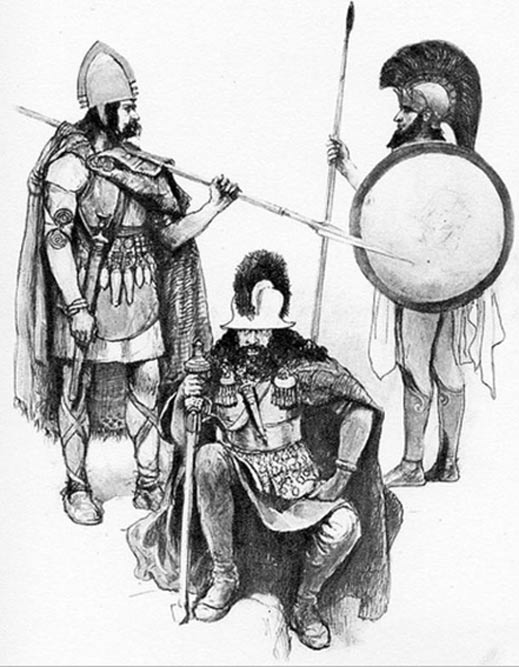
Just a Few Men Controlled Reproduction in Prehistory and Dominate World Genetics Today
A new genetic study of male ancestry shows there were periods in human prehistory when just a few elite men controlled reproduction.
For example, one man about 190,000 years ago was the ancestor of 1,200 living men from 26 groups around the world whose genes were analyzed for the new study.
Who knows if that one man so long ago had great genes? Would the world have been different if it had been another man who had fathered much of the human race?
And one might also wonder just how many women this man had been with in his life. He lived at the dawn of the history of the Homo sapiens species, so perhaps just by dint of arithmetic and not necessarily by having many mates his genes came to dominate humanity.
But thousands of years later, genetic studies show, just a few men were responsible for much of the reproduction.
- Genghis Khan Not the Only Genes in Town - Genetic Founding Fathers of Asia were Mystery Men
- The Prolific Legacies of Ancient Conquerors, 11 Men Shaped Asian Genetics
- Most European Men are Descended from just Three Bronze Age Warlords, New Study Reveals
These tantalizing questions aren’t answered in the press release from the Wellcome Trust Sanger Institute reporting on a new study that found this ancient patriarch’s descendants are all over the world. Dr. Chris Tyler-Smith of the institute headed the study. An institute press release on the largest-ever study of the global genetic variation in the Y (male) chromosome states:
“The study … analysed sequence differences between the Y chromosomes of more than 1200 men from 26 populations around the world using data generated by the 1000 Genomes Project. Analysing the Y chromosomes of modern men can tell us about the lives of our ancestors. The Y chromosome is only passed from father to son and so is wholly linked to male characteristics and behaviours. The team used the data to build a tree of these 1200 Y chromosomes; it shows how they are all related to one another. As expected, they all descend from a single man who lived approximately 190,000 years ago.”
Another finding of the study is that one man who lived in Europe about 4,000 years ago is the ancestor of half of Western European men, Dr. Tyler-Smith told The Telegraph. “In Europe there was huge population expansion in just a few generations,” he told The Telegraph. “Genetics can’t tell us why it happened but we know that a tiny number of elite males were controlling reproduction and dominating the population. Half of the Western European population is descended from just one man.”

World Map of Y-Chromosome Haplogroups - Dominant Haplogroups in Pre-Colonial Populations with Possible Migrations Routes. (CC BY SA 3.0)
Dr. Tyler-Smith says in the press release: “The best explanation is that they may have resulted from advances in technology that could be controlled by small groups of men. Wheeled transport, metal working and organised warfare are all candidate explanations that can now be investigated further.”
The study found an explosion in the population of males around 55,000 to 50,000 years ago in Asia and Europe and about 15,000 years ago in the Americas. Later rapid expansions of male populations happened in sub-Saharan Africa, Western Europe, South Asia, and East Asia between 8,000 and 4,000 years ago.
“The team believes the earlier population increases resulted from the first peopling by modern humans of vast continents, where plenty of resources were available,” the press release states.

Time of haplogroup growth in different parts of the world. (Wellcome Trust Sanger Institute)
Nearly a year ago scientists reported in the journal Nature that the majority of European men are descended from just a handful of Bronze Age male ancestors.
The presence of genetic material from just a few men in the Y chromosome sequence resulted from a population explosion several thousand years ago, researchers said. The team of scientists found that there was a huge increase in the population 2,000 to 4,000 years ago, in a band from Greece and the Balkans to the British Isles and Scandinavia.
The scientists in that study also speculated that perhaps cultural and technological changes were involved in the population explosions.

Bronze-Age warriors. (CC BY NC SA 2.0)
“The population expansion falls within the Bronze Age, which involved changes in burial practices, the spread of horse-riding and developments in weaponry. Dominant males linked with these cultures could be responsible for the Y chromosome patterns we see today,” Professor Mark Jobling of the University of Leicester said.
Featured Image: Imaginative depiction of the Stone Age, by Viktor Vasnetsov. Source: Public Domain
By Mark Miller
















Comments
Don't forgot the Black Plagues of the Medieval Europe as well. This would led to the extinction of some genetic lineages and the rise of other genetic lineages. Then there are the wars that were devastating on the poor civilians (nonsoldiers).
Or more believably, the few survivors after an epidemic/catastrophe carried those genes.
Which, coincidentally, would tie in with the collapse of civilization and population that accompanied the end of the bronze age.
It makes a good case for the plausibility of genetic engineering being done on humans.
I enjoy all of your posts and eagerly await the next one....thank you...
I find your page fascinating and eagerly await any and all of your posts....